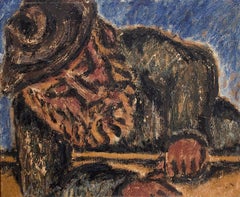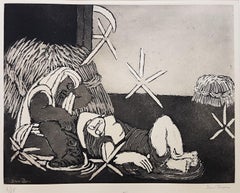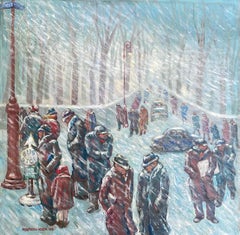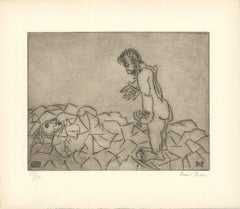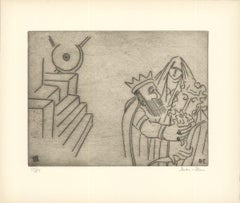Ben-Zion Art
to
2
4
2
2
2
1
1
Overall Height
to
Overall Width
to
2
1
3
2
1
1
1
1
1
1
4
1
1
4
6,847
3,164
2,517
1,217
2
2
1
1
1
Artist: Ben-Zion
Modernist Rabbi at Study Judaica Oil Painting
By Ben-Zion
Located in Surfside, FL
Genre: Judaica
Subject: Religious
Medium: Oil
Surface: Board
Country: United States
Dimensions: 17.5" x 21.75"
Dimensions w/Frame: 24" x 28"
Born in 1897, Ben-Zion Weinman celebrated his European Jewish heritage in his visual works as a sculptor, painter, and printmaker. Influenced by Spinoza, Knut Hamsun, and Wladyslaw Reymont, as well as Hebrew literature, Ben-Zion wrote poetry and essays that, like his visual work, attempt to reveal the deep “connection between man and the divine, and between man and earth.”
An emigrant from the Ukraine, he came to the US in 1920. He wrote fairy tales and Judaic poems in Hebrew under the name Benzion Weinman, but when he began painting he dropped his last name and hyphenated his first, saying an artist needed only one name.
Ben-Zion was a founding member of “The Ten: An Independent Group” The Ten” a 1930’s avant...
Category
Mid-20th Century Modern Ben-Zion Art
Materials
Oil, Board
Ben-Zion (Ukraine, 1897-1987) circa 1930's "Floral Still with White Vase"
By Ben-Zion
Located in SANTA FE, NM
Floral Still Life
Ben-Zion (Ukraine, 1897-1987)
Circa 1930's
Oil on Canvas, signed l.r.
17 3/4 x 12 5/8
One of the founding artists of Abstract Expressionism, hailing from Ukraine, Ben-Zion Weinman arrived in the United States in 1920 after the end of World War l. In America, he became Ben-Zion because to drag around two names was “rather too difficult.”
Ben-Zion was an accomplished, self-taught artist who worked in oils and watercolors. Additionally, Ben-Zion left behind a large body of ironwork. In 1935 he became a founding member of The Ten-a group of artists advancing the concepts of abstraction and expressionism who exhibited together until 1940-along with Mark Rothko, Adolph Gottlieb, and others. Critics immediately began taking notice with an article from the New York Sun...
Category
1930s Abstract Expressionist Ben-Zion Art
Materials
Canvas, Oil
Ruth 3: 7-8
By Ben-Zion
Located in Kansas City, MO
Ben-Zion
Ruth 3: 7-8 (Ruth & Boaz)
From Ruth-Job-Song of Songs portfolio, Plate III (Curt Valentin, New York: 1954)
Etching, aquatint
Edition: 65
Size: 18 x 22 inches
Publisher: Curt...
Category
1950s Modern Ben-Zion Art
Materials
Etching
PROPHET AND SCROLL
By Ben-Zion
Located in Portland, ME
Ben-Zion. PROPHET AND SCROLL. Ink on paper, undated. Titled and
signed in ink lower left. 10 1/8 x 6 3/4 inches. Light foxing or
dampstaining to the sheet. A strong drawing in Ben-Z...
Category
Mid-20th Century Ben-Zion Art
Materials
Ink
Related Items
The Abduction of the Sabine Women , a Renaissance drawing by Biagio Pupini
Located in PARIS, FR
This vigorous drawing has long been attributed to Polidoro da Caravaggio: The Abduction of the Sabine Women is one of the scenes that Polidoro depicted between 1525 and 1527 on the façade of the Milesi Palazzo in Rome. However, the proximity to another drawing inspired by this same façade, kept at the Ecole des Beaux-Arts, and to other drawings inspired by Polidoro kept at the Musée du Louvre, leads us to propose an attribution to Biagio Pupini, a Bolognese artist whose life remains barely known, despite the abundant number of drawings attributed to him.
1. Biagio Pupini, a Bolognese artist in the light of the Roman Renaissance
The early life of Biagio Pupini, an important figure of the first half of the Cinquecento in Bologna - Vasari mentions him several times - is still poorly known. Neither his date of birth (probably around 1490-1495) nor his training are known. He is said to have been a pupil of Francesco Francia (1450 - 1517) and his name appears for the first time in 1511 in a contract with the painter Bagnacavallo (c. 1484 - 1542) for the frescoes of a church in Faenza. He then collaborated with Girolamo da Carpi, at San Michele in Bosco and at the villa of Belriguardo.
He must have gone to Rome for the first time with Bagnacavallo between 1511 and 1519. There he discovered the art of Raphael, with whom he might have worked, and that of Polidoro da Caravaggio. This first visit, and those that followed, were the occasion for an intense study of ancient and modern art, as illustrated by his abundant graphic production.
Polidoro da Caravaggio had a particular influence on the technique adopted by Pupini. Executed on coloured paper, his drawings generally combine pen, brown ink and wash with abundant highlights of white gouache, as in the drawing presented here.
2. The Abduction of the Sabine Women
Our drawing is an adaptation of a fresco painted between 1525 and 1527 by Polidoro da Caravaggio on the façade of the Milesi Palace in Rome. These painted façades were very famous from the moment they were painted and inspired many artists during their stay in Rome. These frescoes are now very deteriorated and difficult to see, as the palace is in a rather narrow street.
The episode of the abduction of the Sabine women (which appears in the centre of the photo above) is a historical theme that goes back to the origins of Rome and is recounted both by Titus Livius (Ab Urbe condita I,13), by Ovid (Fasti III, 199-228) and by Plutarch (II, Romulus 14-19). After killing his twin brother Romus, Romulus populates the city of Rome by opening it up to refugees and brigands and finds himself with an excess of men. Because of their reputation, none of the inhabitants of the neighbouring cities want to give them their daughters in marriage. The Romans then decide to invite their Sabine neighbours to a great feast during which they slaughter the Sabines and kidnap their daughters.
The engraving made by Giovanni Battista Gallestruzzi (1618 - 1677) around 1656-1658 gives us a good understanding of the Polidoro fresco, allowing us to see how Biagio Pupini reworked the scene to extract this dynamic group.
With a remarkable economy of means, Biagio Pupini takes over the left-hand side of the fresco and depicts in a very dense space two main groups, each consisting of a Roman and a Sabine, completed by a group of three soldiers in the background (which seems to differ quite significantly from Polidoro's composition).
The balance of the drawing is based on a very strongly structured composition. The drawing is organised around a median vertical axis, which runs along both the elbow of the kidnapped Sabine on the left and the foot of her captor, and the two main diagonals, reinforced by four secondary diagonals. This diamond-shaped structure creates an extremely dynamic space, in which centripetal movements (the legs of the Sabine on the right, the arm of the soldier on the back at the top right) and centrifugal movements (the arm of the kidnapper on the left and the legs of the Sabine he is carrying away, the arm of the Sabine on the right) oppose each other, giving the drawing the appearance of a whirlpool around a central point of support situated slightly to the left of the navel of the kidnapper on the right.
3. Polidoro da Caravaggio, and the decorations of Roman palaces
Polidoro da Caravaggio was a paradoxical artist who entered Raphael's (1483 - 1520) workshop at a very young age, when he oversaw the Lodges in the Vatican. Most of his Roman work, which was the peak of his career, has disappeared, as he specialised in facade painting, and yet these paintings, which are eminently visible in urban spaces, have influenced generations of artists who copied them abundantly during their visits to Rome.
Polidoro Caldara was born in Caravaggio around 1495-1500 (the birthplace of Michelangelo Merisi, known as Caravaggio, who was born there in 1571), some forty kilometres east of Milan. According to Vasari, he arrived as a mason on the Vatican's construction site and joined Raphael's workshop around 1517 (at the age of eighteen according to Vasari). This integration would have allowed Polidoro to work not only on the frescoes of the Lodges, but also on some of the frescoes of the Chambers, as well as on the flat of Cardinal Bibiena in the Vatican.
After Raphael's death in 1520, Polidoro worked first with Perin del Vaga before joining forces with Maturino of Florence (1490 - 1528), whom he had also known in Raphael's workshop. Together they specialised in the painting of palace façades. They were to produce some forty façades decorated with grisaille paintings imitating antique bas-reliefs.
The Sack of Rome in 1527, during which his friend Maturino was killed, led Polidoro to flee first to Naples (where he had already stayed in 1523), then to Messina. It was while he was preparing his return to the peninsula that he was murdered by one of his assistants, Tonno Calabrese, in 1543.
In his Vite, Vasari celebrated Polidoro as the greatest façade decorator of his time, noting that "there is no flat, palace, garden or villa in Rome that does not contain a work by Polidoro". Polidoro's facade decorations, most of which have disappeared as they were displayed in the open air, constitute the most important lost chapter of Roman art of the Cinquecento. The few surviving drawings of the painter can, however, give an idea of the original appearance of his murals and show that he was an artist of remarkable and highly original genius.
4. The façade of the Milesi Palace
Giovanni Antonio Milesi, who commissioned this palace, located not far from the Tiber, north of Piazza Navona, was a native of the Bergamo area, like Polidoro, with whom he maintained close friendly ties. Executed in the last years before the Sack of Rome, around 1526-1527, the decoration of Palazzo Milesi is considered Polidoro's greatest decorative success.
An engraving by Ernesto Maccari made at the end of the nineteenth century allows us to understand the general balance of this façade, which was still well preserved at the time. The frescoes were not entirely monochrome, but alternated elements in chiaroscuro simulating marble bas-reliefs and those in ochre simulating bronze and gold vases...
Category
16th Century Old Masters Ben-Zion Art
Materials
Ink, Gouache, Pen
Waiting for the Bus in a Blizzard- WPA American Scene 1938 NYC Modernism Realism
By Maurice Kish
Located in New York, NY
Waiting for the Bus in a Blizzard- WPA American Scene 1938 NYC Modernism Realism. 16 x 16 inches, Oil on board, Signed and dated 1938 lower left.
...
Category
1930s American Modern Ben-Zion Art
Materials
Oil, Board
Beautiful Spring Flowers Of My Garden. Original Oil Painting by Lilya Volskaya
Located in Sempach, LU
The paintings are drawn with oil on the canvas.
The brightest flowers that bloom in my garden. They look very much like daisies. They grow up as a group and are different every time....
Category
2010s Abstract Impressionist Ben-Zion Art
Materials
Lacquer, Canvas, Oil
H 19.69 in W 15.75 in D 0.6 in
"Cosmic ecstasy. Abstraction in the style of Kandinsky"by Lilya Volskaya
Located in Sempach, LU
The paintings are drawn with mineral pigments and oil on the canvas.
Cosmic ecstasy. Abstraction in the style of Kandinsky. The painting is made with natural pigments on water. The d...
Category
2010s Abstract Expressionist Ben-Zion Art
Materials
Canvas, Lacquer, Oil, Pigment
H 27.56 in W 19.69 in D 0.6 in
Sakura glamor / Original Gift Art / Blooming trees in spring / 50*60 cm.
Located in Sempach, LU
In this artwork you can feel the vitality and mildness of spring. The blossoms emerge in dynamic strokes, merging impressionism with expressionism's spirit. This painting is ...
Category
2010s Abstract Impressionist Ben-Zion Art
Materials
Oil, Canvas
H 19.69 in W 23.63 in D 0.79 in
Mid-Century Modern Swedish Figurative Oil Painting - Coastal Dock, Framed
Located in Bristol, GB
COASTAL DOCK
Size: 45 x 49.5 cm (including frame)
Oil on board
A vibrant and expressive mid-century figurative painting, executed in oil onto board.
The composition depicts a bustl...
Category
1950s Modern Ben-Zion Art
Materials
Oil, Board
H 17.72 in W 19.49 in
"A summer's day with pink peonies. " Oil still life by Lilya Volskaya
Located in Sempach, LU
The paintings are drawn with oil on the canvas.
A summer's day with pink peonies. A sunny, bright picture. oil painting on a circular canvas. The painting's borders are not the limi...
Category
2010s Abstract Expressionist Ben-Zion Art
Materials
Lacquer, Canvas, Oil
H 15.75 in W 15.75 in D 0.6 in
Four Figures and a Head, on Giant Phallus by Claes Oldenburg erotic nude scene
By Claes Oldenburg
Located in New York, NY
This sensuous and playful scene is characteristic of Oldenburg’s printmaking ouevre: a veritable heap of women displaying various expressions of joy and come-hither coquettishness. T...
Category
1970s Modern Ben-Zion Art
Materials
Etching
Original Antique American Landscape Fishing Delaware River Oil Painting Framed
Located in Buffalo, NY
A lovely scene adeptly painted by listed American artist and illustrator Jan Nosek (1876 - 1966) who was active in the late 19th and early 20th Century. This scene created in the ea...
Category
1910s American Modern Ben-Zion Art
Materials
Oil, Board
Mount Fuji welcomes Spring / Original Art / Blooming trees in spring / 60*80 cm.
Located in Sempach, LU
The sacred Mount Fuji is located on the Japanese island of Honshu, 100 kilometers from the city of Tokyo. The mountain is a dormant volcano and is the highest in Japan. Accordi...
Category
2010s Abstract Impressionist Ben-Zion Art
Materials
Canvas, Acrylic
Vik Schroeder Mount Fuji welcomes Spring / Original Art / Blooming trees in spring / 60*80 cm., 2024
No Reserve
H 23.63 in W 31.5 in D 0.79 in
Vintage Mid-Century Swedish Unframed Figurative Oil Painting - Affection
Located in Bristol, GB
AFFECTION
Size: 41 x 33 cm
Oil on board
A tender and captivating mid-century figurative painting, executed in oil onto board and dated 1944.
A female figure in a flowing red dress ...
Category
1940s Modern Ben-Zion Art
Materials
Oil, Board
"Tailor" WPA American Scene Social Realism Modernism Mid Century Modern Fashion
By Mervin Jules
Located in New York, NY
"Tailor" WPA American Scene Social Realism Modernism Mid Century Modern Fashion
The board measures 9 1/2 x 15 1/2.
Provenance: Mervin Jules Estate.
Bio
A painter, illustrator, pri...
Category
1930s American Modern Ben-Zion Art
Materials
Oil, Board
Previously Available Items
1966 Ben-Zion 'Gilgamesh Meets Deceased Enkidu's Shadow, Inquires About Death
By Ben-Zion
Located in Brooklyn, NY
Paper Size: 15 x 17.5 inches ( 38.1 x 44.45 cm )
Image Size: 10 x 13.25 inches ( 25.4 x 33.655 cm )
Framed: No
Condition: A-: Near Mint, very light signs of handling
Additional...
Category
1960s Ben-Zion Art
Materials
Etching
H 15 in W 17.5 in D 0.1 in
1966 Ben-Zion 'Gilgamesh Embraces Enkidu After Test of Strength (XIX)' Gray
By Ben-Zion
Located in Brooklyn, NY
Paper Size: 15 x 17.5 inches ( 38.1 x 44.45 cm )
Image Size: 10 x 13.25 inches ( 25.4 x 33.655 cm )
Framed: No
Condition: A-: Near Mint, very light signs of handling
Additional...
Category
1960s Ben-Zion Art
Materials
Etching
H 15 in W 17.5 in D 0.1 in
1966 Ben-Zion 'Gilgamesh Goes to His Mother (XXXV)' Gray Etching
By Ben-Zion
Located in Brooklyn, NY
Paper Size: 15 x 17.5 inches ( 38.1 x 44.45 cm )
Image Size: 10 x 13.25 inches ( 25.4 x 33.655 cm )
Framed: No
Condition: A-: Near Mint, very light signs of handling
Additional...
Category
1960s Ben-Zion Art
Materials
Etching
H 15 in W 17.5 in D 0.1 in
1966 Ben-Zion 'Gilgamesh Then Sees a Shimmer of the Sun (XXXIII)' Gray Etching
By Ben-Zion
Located in Brooklyn, NY
Paper Size: 15 x 17.5 inches ( 38.1 x 44.45 cm )
Image Size: 10 x 13.25 inches ( 25.4 x 33.655 cm )
Framed: No
Condition: A-: Near Mint, very light signs of handling
Additional...
Category
1960s Ben-Zion Art
Materials
Etching
H 15 in W 17.5 in D 0.1 in
1966 Ben-Zion 'Gilgamesh Leaves His Palace (XXX)' Gray Etching
By Ben-Zion
Located in Brooklyn, NY
Paper Size: 15 x 17.5 inches ( 38.1 x 44.45 cm )
Image Size: 10 x 13.25 inches ( 25.4 x 33.655 cm )
Framed: No
Condition: A-: Near Mint, very light signs of handling
Additional...
Category
1960s Ben-Zion Art
Materials
Etching
H 15 in W 17.5 in D 0.1 in
1966 Ben-Zion 'The Priestess Leads Enkidu to Uruk (XVII)' Gray Etching
By Ben-Zion
Located in Brooklyn, NY
Paper Size: 15 x 17.5 inches ( 38.1 x 44.45 cm )
Image Size: 10 x 13.25 inches ( 25.4 x 33.655 cm )
Framed: No
Condition: A-: Near Mint, very light signs of handling
Additional...
Category
1960s Ben-Zion Art
Materials
Etching
H 15 in W 17.5 in D 0.1 in
1966 Ben-Zion 'Enkidu Confronts Gilgamesh (XVIII)' Gray Etching
By Ben-Zion
Located in Brooklyn, NY
Paper Size: 15 x 17.5 inches ( 38.1 x 44.45 cm )
Image Size: 10 x 13.25 inches ( 25.4 x 33.655 cm )
Framed: No
Condition: A-: Near Mint, very light signs of handling
Additional...
Category
1960s Ben-Zion Art
Materials
Etching
H 15 in W 17.5 in D 0.1 in
1966 Ben-Zion 'Enkidu Curses the Priestess (XXIV)' Gray Etching
By Ben-Zion
Located in Brooklyn, NY
Paper Size: 15 x 17.5 inches ( 38.1 x 44.45 cm )
Image Size: 10 x 13.25 inches ( 25.4 x 33.655 cm )
Framed: No
Condition: A-: Near Mint, very light signs of handling
Additional...
Category
1960s Ben-Zion Art
Materials
Etching
H 15 in W 17.5 in D 0.1 in
1966 Ben-Zion 'The Priestess Teaches Enkidu to Hunt (XVI)' Gray Etching
By Ben-Zion
Located in Brooklyn, NY
Paper Size: 15 x 17.5 inches ( 38.1 x 44.45 cm )
Image Size: 10 x 13.25 inches ( 25.4 x 33.655 cm )
Framed: No
Condition: A-: Near Mint, very light signs of handling
Additional...
Category
1960s Ben-Zion Art
Materials
Etching
H 15 in W 17.5 in D 0.1 in
Modernist Rabbi at Study Judaica Oil Painting
By Ben-Zion
Located in Surfside, FL
Genre: Judaica
Subject: Religious
Medium: Oil
Surface: Board
Country: United States
Dimensions: 17.5" x 21.75"
Dimensions w/Frame: 24" x 28"
Born in 1897, Ben-Zion Weinman celebrat...
Category
Mid-20th Century Modern Ben-Zion Art
Materials
Oil, Board
Ben-zion art for sale on 1stDibs.
Find a wide variety of authentic Ben-Zion art available for sale on 1stDibs. You can also browse by medium to find art by Ben-Zion in oil paint, paint, board and more. Much of the original work by this artist or collective was created during the 20th century and is mostly associated with the modern style. Not every interior allows for large Ben-Zion art, so small editions measuring 7 inches across are available. Customers who are interested in this artist might also find the work of August Mosca, Florence E. Nosworthy, and William Harnden. Ben-Zion art prices can differ depending upon medium, time period and other attributes. On 1stDibs, the price for these items starts at $250 and tops out at $8,640, while the average work can sell for $2,488.
